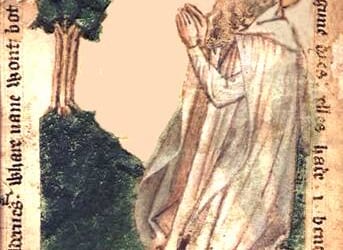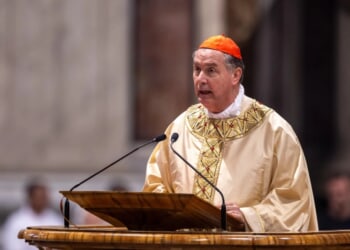The devotion to the Sacred Heart of Jesus is a profound and essential aspect of Catholic spirituality, encapsulating the love and compassion of Christ towards humanity. It is about the depths of the heart of Jesus, as is aptly described in the liturgy’s use of Ephesians 3: “And I pray that you, being rooted and established in love, may have power, together with all the Lord’s holy people, to grasp how wide and long and high and deep is the love of Christ, and to know this love that surpasses knowledge—that you may be filled to the measure of all the fullness of God.” The width and the length and the height and the depths of His love are truly immeasurable.
This devotion centers on the mercy of God, which cannot be understood apart from His justice. When one truly comprehends, in justice, how grave sin is and then witnesses the profound love that Jesus extends when he seeks forgiveness, he begins to grasp the depths of this love—something that the judicious demons can never understand. They weigh all of our sins and demand payment for them upon judgment, but if we have relied on the mercy that God shows us, much like the blood flowing from the side of Christ when Longinus’ sword pierces it, then and only then can we be saved and taste the deep love of God for us.
Like all devotions, that of the Sacred Heart is tied to the will and to the heart of man. It is a true devotion that deals with the heart of man and the heart of God, almost like a cor ad cor loquitur (“heart speaks to heart”). This devotion is notably linked to the apparition of the Sacred Heart to St. Margaret Mary Alacoque in 1673, where Jesus revealed His heart as a symbol of His divine love. However, a deeper historical and spiritual context emerges when we consider this event alongside the miraculous Eucharistic phenomenon of Lanciano, which occurred nearly a millennium earlier in the 600s.
The Miracle of Lanciano: A Prelude
In the year 600, a priest in Lanciano, Italy, was celebrating the Holy Eucharist when he experienced a profound crisis of faith regarding the Real Presence of Christ in the Eucharist. As he uttered the words of consecration, the bread and wine transformed into actual flesh and blood. This miracle, recognized by the Church, has been scientifically examined and confirmed, revealing that the flesh is of cardiac origin, linking it directly to the heart of Jesus. This Eucharistic Miracle occurred before Islam would expand across the world, emphasizing the necessity of reaffirming the Christian Faith amidst challenges, but also illustrating how God assumed our humanity.
To understand the implications of the Sacred Heart devotion more profoundly, we must consider the historical backdrop of Christological debates, particularly the Monophysite heresy of 446. This heresy posited that Christ has only one nature, which is divine, effectively diminishing the significance of His humanity. The Council of Chalcedon in 451 responded decisively to this teaching, affirming that Christ is both fully divine and fully human, two natures in one person. This understanding is critical, as it underscores the richness of Christ’s love and sacrifice, which is fully realized in His human experience.
This theological tension is mirrored in the Islamic conception of God, which does not recognize the divinity of Christ, viewing the notion of God assuming human nature as impossible. In Islam, God remains distant. This perspective resonates with the deism that emerged in the 18th century, wherein God is perceived as an impersonal creator, far removed from the intimate relationship offered through the Sacred Heart.
Thus, the fact that there is a miracle of Lanciano shortly before the appearance of Islam and that the Sacred Heart appears shortly before the rise of Masonic deism in the 18th century is not a coincidence. To understand more profoundly the role of private revelation throughout history, one must grasp how important Revelation (which we see as both Scripture and Tradition) is to the historia salutis. Christ, after all, was Incarnate “in the fullness of time” (Gal. 4:4), and the fruits of His work continue in the Church which He founded, the Body of Christ and Temple of the Holy Spirit. The Holy Spirit continues to guide the Church throughout history, and miracles such as that of Lanciano or apparitions like that of the Sacred Heart to St. Margaret Mary are part of the Divine Intervention in the history of the Church and mankind for the salvation of souls.
The Apparition to St. Margaret Mary
Fast forward to the late 17th century: in 1673, St. Margaret Mary Alacoque, a French nun of the Visitation order, received a series of apparitions from Jesus. In these visions, He revealed His Sacred Heart, inviting her and the world to contemplate the depths of His love and mercy. This profound revelation came in a time of spiritual need, just a century before the French Revolution, a period marked by upheaval and the questioning of faith and authority.
To deepen this devotion, Jesus requested specific practices, including the First Friday Devotion, where Catholics receive Holy Communion on the first Friday of nine consecutive months. This practice is aimed at making reparations for the sins committed against the Heart of Christ and enables the faithful to grow closer to Him. Jesus promised St. Margaret Mary that He would grant twelve special and powerful graces to those who complete the nine First Fridays, including:
- All the graces necessary for their state of life.
- Peace in their families.
- Comfort in trials.
- A secure refuge during life and death.
- Abundant blessings upon all their undertakings.
- The source of infinite mercy for sinners.
- Lukewarm souls shall become fervent.
- Fervent souls shall reach high perfection.
- Blessings on places where His image is honored.
- The gift of touching hardened hearts to priests.
- Names written in His Heart for those promoting this devotion.
- The grace of final repentance for those receiving Holy Communion as promised.
These promises encapsulate Jesus’ immense love and desire for a closer relationship with humanity.
The Symbols of the Sacred Heart
The image of the Sacred Heart of Jesus is rich with symbolism. The exposed Heart, often depicted with a crown of thorns, represents Jesus’ suffering and His immense love for humanity. The flames emanating from the Heart signify the transformative and purifying power of His love, while the cross above the Heart is a reminder of His redemptive sacrifice for the sins of the whole world. The wound in the side of His Heart represents the wound inflicted on Him by both the Roman soldier and by all human beings through their sins.
Historical Context and the Metaxy
The significance of these events is not merely chronological; they resonate with the idea of “metaxy,” a term articulated by Plato and later explored by St. Augustine in his Confessions. St. Augustine outlined four significations of time: psychological, physical, moral, and historical. In his exploration of time’s relationship with eternity, St. Augustine posited that the past, present, and future are always “present with us.” This psychological view suggests that we are constantly at the intersection of these temporal points.
In Book XI of Confessions, St. Augustine shows that the future, past, and present exist in the soul through psychic acts. This echoes Plato’s notion of “metaxy,” described by Eugene Webb as “the experience of human existence as ‘between’ lower and upper poles: man and the divine, imperfection and perfection, ignorance and knowledge.” In this context, the events surrounding the Sacred Heart’s revelation and the Miracle of Lanciano can be seen as pivotal moments in the human experience, bridging the divine and the earthly, the supernatural and the historical.
The Sacred Heart’s revelation came just a few years before the English Glorious Revolution (1688) and the reign of Peter the Great in Russia (1689)—critical moments that shaped the course of modern history. Each of these events serves as a reminder that God is actively involved in the unfolding of human history, guiding and preparing hearts for a deeper understanding of His love.
Papal Endorsements of the Devotion
The Catholic Church has long promoted devotion to the Sacred Heart. In 1856, Blessed Pope Pius IX extended the Feast of the Sacred Heart to the universal Church, recognizing its profound significance. Pope Leo XIII and Ven. Pope Pius XII further encouraged this devotion through their encyclicals, Annum Sacrum and Haurietis Aquas, respectively, emphasizing Jesus’ powerful love and the importance of consecrating ourselves to His Sacred Heart. Additionally, Pope St. John Paul II spoke passionately about the Sacred Heart, urging the faithful to embrace this devotion as a means of experiencing the love of God more fully.
Conclusion
The devotion to the Sacred Heart of Jesus stands as a testament to the divine love that transcends and penetrates time and circumstance. God is not distant. He is very involved in our lives, in our history. By linking the apparition to St. Margaret Mary and the Eucharistic Miracle of Lanciano, we uncover a profound narrative that speaks to the heart of humanity’s relationship with the divine. In recognizing the metaxy of these events, we see how God’s love continually intersects with human history, inviting us to respond to His heart with our own.
Image from the Surrender Novena Pamphlet














